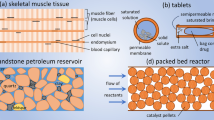Abstract
The purpose of the work is development of algorithms for separate mapping of T 2 relaxation time and gradients, using gradient recalled echo (GRE) sequence. Application of three-dimensional (3D) model of gradients and their volumetric averaging within a voxel lead to analytical model of relaxation function, which is consistent with experimental data for both regular macroscopic and randomized micro- and mesoscopic gradients. The model is verified by fitting into experimental data obtained on specially made phantoms. Verification of algorithms is completed by comparing gradient maps obtained on specially made cylindrical phantoms with theoretical maps of their exact 3D electro-dynamic solutions. Analytical model of relaxation function proved to be in good agreement with experimental relaxation curves. On the basis of this model, fast and unambiguous fittingless algorithms were developed. Gradient maps measured on special cylindrical phantoms are in good qualitative agreement with theory. 3D statistical model and fittingless algorithms provide the basis for separating the GRE signal into two meaningful parameters—T 2 and gradients, thus doubling information from magnetic resonance imaging.












Similar content being viewed by others
References
M.E. Tang, T.W. Chen, X.M. Zhang, X.H. Huang, BioMed Research International 2014 [Online]. http://dx.doi.org/10.1155/2014/312142 (article ID 312142). Accessed 8 Feb 2017
G.B. Chavhan, P.S. Babyn, B.T. Manohar, M. Shroff, E.M. Haacke, Principles. RadioGraphics 29(5), 1433–1449 (2009)
F. Bloch, Phys. Rev. 70, 460–474 (1946)
H.C. Torrey, Phys. Rev. 104, 563–565 (1956)
D.A. Yablonskiy, E.M. Haacke, Magn. Reson. Med. 321, 749–763 (1994)
A.L. Sukstanskii, D.A. Yablonskiy, J. Magn. Reson. 163, 236–247 (2003)
A.L. Sukstanskii, D.A. Yablonskiy, J. Magn. Reson. 167, 56–67 (2004)
V.G. Kiselev, J. Magn. Reson. 170, 228–235 (2004)
J.D. Dickson, T.W.J. Ash, G.B. Williams, A.L. Sukstanskii, R.E. Ansorge, D.A. Yablonskiy, J. Magn. Reson. 212, 17–25 (2011)
M.J. Knight, R.A. Kauppinen, J. Magn. Reson. 269, 1–12 (2016)
M.A. D’Avila, R.L. Powell, R.J. Phillips, N.C. Shapley, J.H. Walton, S.R. Dungan, Braz. J. Chem. Eng. 22, 49–60 (2005)
L.R. Schad, G. Brix, I. Zuna, W. Harle, W.J. Lorenz, W. Semmler, J. Comput. Assist. Tomogr. 13, 577–587 (1989)
G.E. Hagberg, I. Indovina, J.N. Sanes, S. Posse, Magn. Reson. Med. 48, 877–882 (2002)
M.A. Fernandez-Seara, F.W. Wehrli, Magn. Reson. Med. 44, 358–366 (2000)
H. Dahnke, T. Schaeffter, Magn. Reson. Med. 53, 1202–1206 (2005)
L.W. Hofstetter, G. Morrell, J. Kaggie, D. Kim, K. Carlston, V.S. Lee, Magn. Reson. Med. (2016). doi:10.1002/mrm.26240
X. Yang, S. Sammet, P. Schmalbrock, M.V. Knopp, Magn. Reson. Med. 63, 1258–1268 (2010)
M.A. Bernstein, X.J. Zhou, J.A. Polzin, K.F. King, A. Ganin, N.J. Pelc, G.H. Glover, Magn. Reson. Med. 39, 300–308 (1998)
D.W. Marquardt, J. Soc. Ind. Appl. Math. 11, 431–441 (1963)
W.H. Press, S.A. Teukolsky, W.T. Wetterling, B.P. Flannery, Numerical Recipes in Fortran 77, 2nd edn. (Cambridge University Press, New York, 1992), Ch.15
E.M. Haacke, R.W. Brown, M.R. Thompson, R. Venkatesan, Magnetic Resonance Imaging: Physical Principles and Sequence Design (Wiley-Liss, New York, 1999), Ch.25, pp. 741–779
Acknowledgements
I am grateful to Prof. V.G. Kiselev and Dr. J. Sedlachek for fruitful discussions, and to Prof. A.V. Melerzanov for support and encouragement.
Author information
Authors and Affiliations
Corresponding author
Appendix
Appendix
Functions R p (x) in Eq. 12 may be obtained by averaging sinc(αt) in Eq. 6 over α not only with Gaussian distribution Eq. 9, but with any other suitable probability distributions. Any probability density function for the random variable α, specified by its characteristic spread σ and average value \(\bar{\alpha }\), may be written in parametric form
with dimensionless argument u = α/σ and parameter \(p = {{\bar{\alpha }} \mathord{\left/ {\vphantom {{\bar{\alpha }} \sigma }} \right. \kern-0pt} \sigma }\). Then average relaxation function may be written as a function of a dimensionless argument x = σt:
For example, consider three simplest limited-range distributions together with the unlimited Gaussian one:
α = arccos (1/e);
All these distributions are normalized to unity integral and to equal characteristic spread σ when the function falls to 1/e of its maximum (Fig. 13). This is a standard criterion for exponential functions.
In the text, we calculated the integral (Eq. 36) analytically for Gaussian distribution (Eq. 40), using complex variables. Now consider results of numerical computations in comparison with limited-range distributions (Eqs. 37–39). The result is shown in Fig. 14, and is almost identical for all the four probability distributions. Thus, it is possible to conclude that actual form of a probability density of gradients does not change the result within practically expected precision of measurements, and Gaussian distribution can be used without limitations.
Rights and permissions
About this article
Cite this article
Protopopov, A.V. Relaxation Model and Mapping of Magnetic Field Gradients in MRI. Appl Magn Reson 48, 255–274 (2017). https://doi.org/10.1007/s00723-017-0863-3
Received:
Published:
Issue Date:
DOI: https://doi.org/10.1007/s00723-017-0863-3






